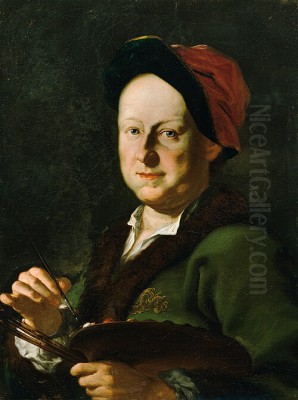
August Querfurt stands as a notable figure in 18th-century German art, an artist whose canvases vividly captured the tumult and drama of his time. Born in Wolfenbüttel, Germany, in 1696, and passing away in the imperial city of Vienna in 1761, Querfurt dedicated his career to depicting history, particularly the intense conflicts and grand hunting expeditions that characterized the Baroque era. Though perhaps less revolutionary than some contemporaries, his work provides an invaluable window into the military and social life of Central Europe, rendered with meticulous detail and dramatic flair.
Early Life and Artistic Formation
August Querfurt's journey into the world of art began under the direct tutelage of his father, Tobias Querfurt, himself a painter. This familial introduction to the craft provided a foundational understanding of technique and composition. His formal training extended beyond the family workshop; he honed his skills at the renowned Rugendas school in Augsburg. This institution, likely associated with Georg Philipp Rugendas I, a master known for his own dynamic battle scenes and depictions of horses, would have immersed Querfurt in a tradition that prized anatomical accuracy and energetic portrayal of movement, particularly relevant for his future specializations.
The artistic environment of early 18th-century Germany was a melting pot of influences. While the grandeur of the Italian Baroque still held sway, Northern European traditions, particularly the Dutch Golden Age's precision and the Flemish Baroque's dynamism, were deeply ingrained. Querfurt emerged from this context, equipped with technical skill and exposed to various stylistic currents that would shape his artistic identity. His education in both Wolfenbüttel and Augsburg placed him at a crossroads of these influences, preparing him for a career focused on subjects demanding both detail and drama.
Weaving Influences: Shaping a Distinctive Style
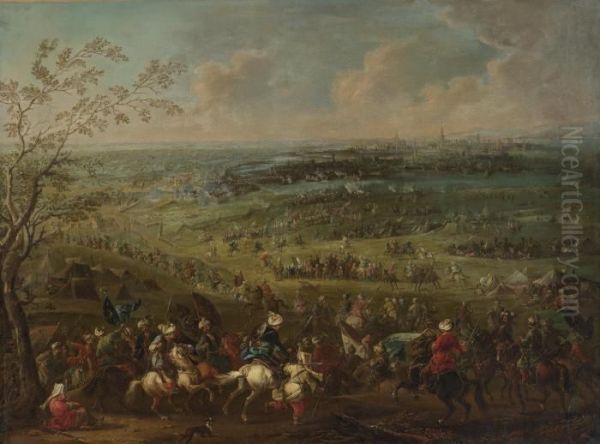
Querfurt's artistic output reveals a keen study of several prominent masters who excelled in genres related to his interests. His style, while distinctly his own, echoes the achievements of artists he clearly admired. The influence of Dutch Golden Age painter Philips Wouwerman is particularly evident. Wouwerman was celebrated for his elegant depictions of cavalry skirmishes, hunting parties, and landscapes, always featuring exquisitely rendered horses. Querfurt adopted Wouwerman's attention to equine anatomy and the lively arrangement of figures in outdoor settings, though often infusing his scenes with a greater sense of urgency.
The dramatic intensity found in Querfurt's battle pieces owes a debt to French artists like Joseph Parrocel. Parrocel specialized in large-scale, dynamic battle paintings, capturing the chaos and energy of combat with swirling compositions and vigorous brushwork. Querfurt absorbed this sense of movement and drama, applying it to his own depictions of historical conflicts. Similarly, the work of Adam Frans van der Meulen, court painter to Louis XIV, known for his panoramic battle scenes and detailed recording of military campaigns, likely informed Querfurt's approach to composing large-scale historical narratives and his commitment to detail in uniforms and equipment.
Further influences can be traced. The intricate figure groupings and sometimes grim realities depicted by the earlier French etcher Jacques Callot, famous for his series "The Miseries of War," might have impacted Querfurt's handling of numerous figures within complex scenes. The Dutch painter Jan van Huchtenburgh, who also specialized in cavalry charges and battle scenes and worked internationally, represents another parallel and potential influence in the Northern European tradition of military painting. Querfurt synthesized these various strands, creating a style characterized by detailed realism, particularly in rendering horses and military gear, combined with dynamic, often theatrical compositions. His palette could range from brighter tones in hunting scenes to darker, more somber hues in the thick of battle.
Master of the Battlefield: Thematic Focus
Battle painting flourished during the Baroque period, serving multiple purposes. It commemorated glorious victories, documented historical events, served as propaganda for rulers, and catered to an aristocratic taste for scenes of valor and action. Europe was frequently embroiled in conflict during Querfurt's lifetime, including the War of the Spanish Succession and the ongoing struggles between the Habsburg Empire and the Ottoman Empire. Querfurt's specialization in this genre placed him firmly within a popular and relevant artistic tradition.
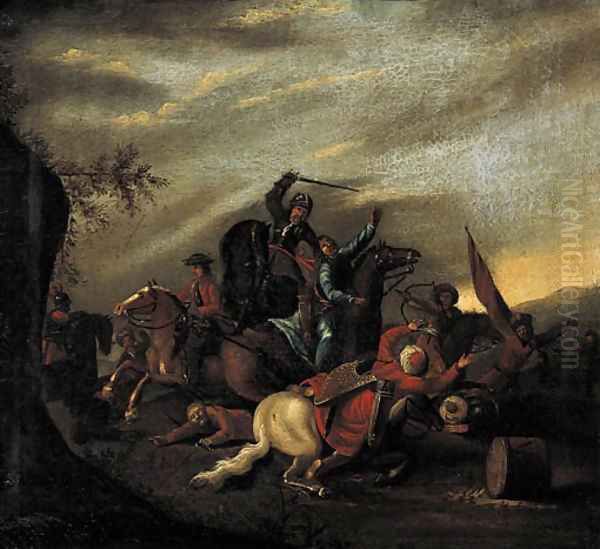
His focus on military subjects, particularly cavalry engagements and historical battles, allowed him to showcase his skill in depicting horses in motion, the glint of armor, and the complex choreography of warfare. Artists like Jacques Courtois, known as 'Il Borgognone,' had earlier set a high standard for battle painting across Europe, and Querfurt operated within this established field. While specific patrons for every work are not always known, his choice of subject matter, especially scenes involving the Habsburg military and the defense against the Ottomans, suggests alignment with imperial interests and likely appealed to military figures and the aristocracy in Vienna, where he later settled.
Querfurt's hunting scenes, another significant part of his oeuvre, shared similarities with his battle paintings. They often featured dynamic compositions, skilled depictions of animals (horses and hounds), and detailed natural settings, catering to the aristocratic pastime of the hunt. These works allowed for a slightly lighter, though still energetic, mood compared to the intensity of his battle pieces.
Chronicling History: Major Works
Among August Querfurt's most significant contributions are his depictions of the pivotal events surrounding the Siege of Vienna in 1683. This historical moment, when the Ottoman Empire's advance into Europe was decisively halted at the gates of Vienna by the combined forces of the Holy Roman Empire and the Polish-Lithuanian Commonwealth led by King Jan III Sobieski, was a subject of immense importance and resonance, especially in Vienna itself.
His painting often titled The Turkish Siege of Vienna captures the scale and drama of this extended conflict. It portrays the encampments, the fortifications, and the sense of impending clash between the vast Ottoman army and the city's defenders. Querfurt meticulously renders details of military life, equipment, and the landscape, providing a visual record of this crucial historical episode.
Closely related, and perhaps even more famous, is his Battle of Kahlenberg. This work focuses on the decisive moment of relief, depicting the charge of the Christian forces, particularly the Polish cavalry, sweeping down from the Kahlenberg heights to break the siege. Querfurt excels here in conveying the momentum and chaos of the cavalry charge, the clash of arms, and the turning tide of battle. The painting is a dynamic composition filled with movement, showcasing his mastery of depicting horses and riders in complex action.
Beyond these large-scale historical narratives, Querfurt produced numerous other works featuring cavalry skirmishes, often untitled or generically named Cavalry Battle. These pieces allowed him to explore variations on his favorite themes, focusing on smaller groups of combatants in dramatic, often atmospheric settings. He also demonstrated skill in portraiture, as seen in his Portrait of Charles Alexander, Duke of Württemberg, proving his versatility beyond scenes of conflict and hunt.
Querfurt in Vienna: An Imperial Stage
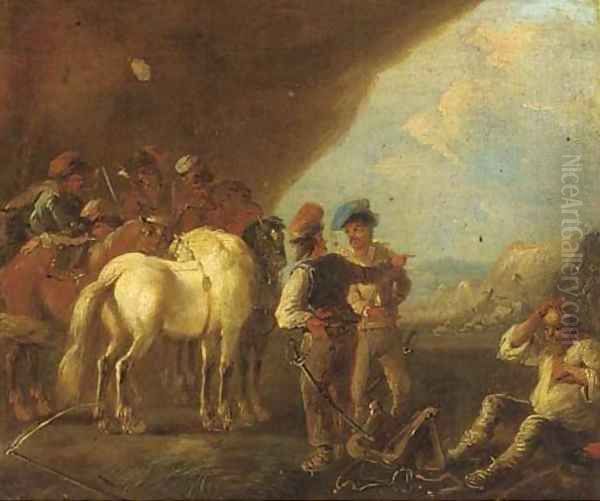
August Querfurt spent a significant portion of his later career in Vienna, the vibrant capital of the Habsburg Empire. He died there in 1761. Vienna in the 18th century was a major European center for the arts, dominated by the opulent tastes of the imperial court and aristocracy. The city was undergoing a construction boom, with magnificent Baroque palaces and churches being erected and decorated. This environment provided opportunities but also presented a specific artistic context.
While Querfurt focused on easel painting, much of the high-profile artistic activity in Vienna revolved around large-scale fresco decorations for ceilings and walls in palaces and churches. Leading figures of the Austrian Baroque like Johann Michael Rottmayr, Martino Altomonte (Italian-born but highly active in Austria), Daniel Gran, and the slightly later Paul Troger were transforming interiors with vast, illusionistic scenes, often allegorical or religious. Their work represented the grand, decorative, and often lighter, proto-Rococo tendencies developing in Austrian art.
Querfurt's work, with its focus on detailed historical and genre scenes in oil on canvas, occupied a different niche. His style, rooted more firmly in Northern European traditions of realism and influenced by French and Dutch battle painters, contrasted with the prevailing taste for monumental ceiling frescoes. However, his chosen subjects – military victories, imperial history, and aristocratic pursuits like hunting – certainly found an audience within the military and courtly circles of the Habsburg capital. His presence in Vienna added another dimension to the city's diverse artistic landscape.
Comparisons and Context in 18th-Century Art
Placing August Querfurt within the broader panorama of 18th-century European art helps to understand his specific contribution. While he worked during the transition from late Baroque to Rococo, his style remained largely anchored in the dramatic realism suited to his subject matter. This contrasts sharply with the leading figure of the Venetian Rococo, Giovanni Battista Tiepolo, whose vast, light-filled frescoes and canvases overflowed with mythological figures, airy compositions, and a palette of pastel hues. Tiepolo represented the height of decorative fantasy, whereas Querfurt remained focused on tangible historical or genre reality.
Comparing him to other German-speaking contemporaries reveals the diversity of the era. In Prussia, the French-born Antoine Pesne served as court painter, excelling in elegant Rococo portraits that captured the sophistication of Frederick the Great's court. His style was lighter and more focused on aristocratic grace than Querfurt's robust scenes. Further afield, artists like Canaletto in Venice were perfecting the veduta or cityscape, applying meticulous detail to urban views, a different kind of realism altogether. Querfurt's specialization was distinct within this varied landscape.
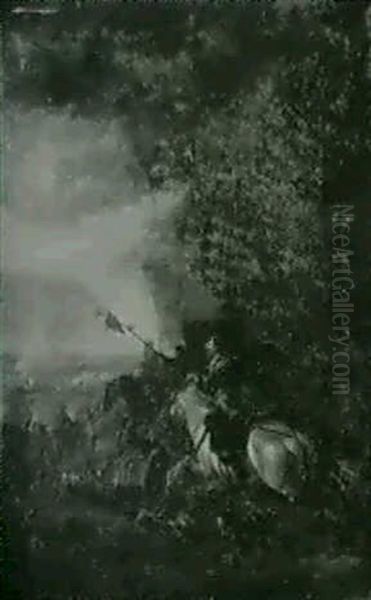
His adherence to the detailed, action-oriented style of earlier battle painters like Wouwerman and Parrocel, while demonstrating technical mastery, also led to later assessments that sometimes characterized his work as skillful but somewhat derivative. He did not radically innovate in the way some of his contemporaries did, but he perfected a specific type of historical and military painting that fulfilled a clear demand.
Later Life, Legacy, and Evaluation
August Querfurt continued to paint until his death in Vienna in 1761. His works were acquired by important collectors and institutions during his lifetime and afterwards. Today, his paintings can be found in major European museums, including the Hermitage Museum in St. Petersburg, the Gemäldegalerie Alte Meister in Dresden, and the Kunsthistorisches Museum in Vienna, as well as in numerous other public and private collections.
His historical evaluation acknowledges his considerable skill as a draftsman and painter, particularly his ability to render horses, military details, and complex figural arrangements with accuracy and energy. He is recognized as a significant practitioner of battle and hunting painting in the German-speaking world during the 18th century. His depictions of specific historical events, like the Siege of Vienna, are valued not only as artistic creations but also as important visual documents that offer insights into the military history and culture of the period.
However, art historical assessments often note his reliance on established models and influences. While highly competent, he is generally not placed among the most innovative or influential artists of the 18th century. His reputation rests primarily on his role as a specialist, a master craftsman within his chosen genres, rather than as a groundbreaking visionary. Nevertheless, his contribution remains significant for his vivid portrayal of a specific historical epoch and its characteristic conflicts and pastimes.
Conclusion: A Painter of History and Action
August Querfurt carved a distinct niche for himself in the art world of the 18th century. As a specialist in battle scenes, historical events, and hunting expeditions, he captured the dynamism and specific details of his time with remarkable skill. Drawing inspiration from Dutch, Flemish, and French masters, he forged a style suited to the dramatic intensity of cavalry charges and the meticulous rendering of military life. While perhaps overshadowed by contemporaries who pursued grander decorative schemes or pioneered new stylistic paths, Querfurt's work endures. His canvases offer a compelling visual narrative of Baroque warfare and aristocratic life, securing his place as a valuable chronicler of history and a master of action painting in the German tradition.